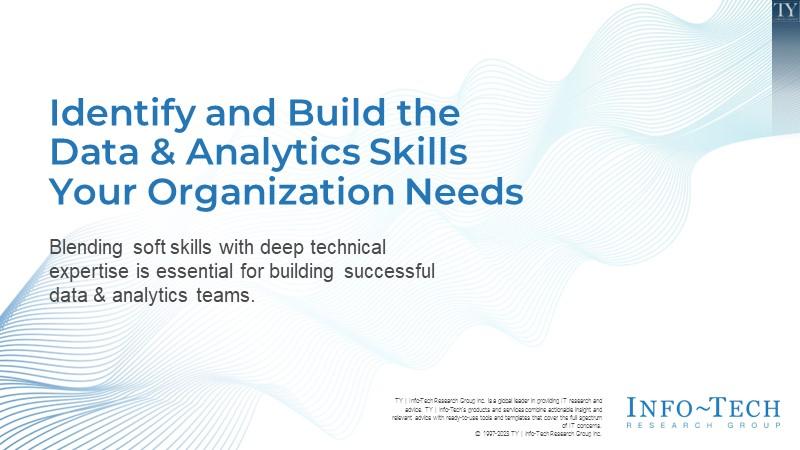
Identify and Build the Data & Analytics Skills Your Organization Needs
The rapid technological evolution in platforms, processes, and applications is leading to gaps in the skills needed to manage and use data. Some common obstacles that could prevent you from identifying and building the data & analytics skills your organization needs include:
- Lack of resources and knowledge to secure professionals with the right mix of D&A skills and right level of experience/skills
- Lack of well-formulated and robust data strategy
- Underestimation of the value of soft skills
Our Advice
Critical Insight
Skill deficiency is frequently stated as a roadblock to realizing corporate goals for data & analytics. Soft skills and technical skills are complementary, and data & analytics teams need a combination of both to perform effectively. Identify the essential skills and the gap with current skills that fit your organization’s data strategy to ensure the right skills are available at the right time and minimize pertinent risks.
Impact and Result
Follow Info-Tech's advice on the roles and skills needed to support your data & analytics strategic growth objectives and how to execute an actionable plan:
- Define the skills required for each essential data & analytics role.
- Identify the roles and skills gaps in alignment with your current data strategy.
- Establish an action plan to close the gaps and reduce risks.
Identify and Build the Data & Analytics Skills Your Organization Needs Research & Tools
Besides the small introduction, subscribers and consulting clients within this management domain have access to:
1. Identify and Build the Data & Analytics Skills Your Organization Needs Deck – Use this research to assist you in identifying and building roles and skills that are aligned with the organization’s data strategy.
To generate business value from data, data leaders must first understand what skills are required to achieve these goals, identify the current skill gaps, and then develop skills development programs to enhance the relevant skills. Use Info-Tech's approach to identify and fill skill gaps to ensure you have the right skills at the right time.
- Identify and Build the Data & Analytics Skills Your Organization Needs Storyboard
2. Data & Analytics Skills Assessment and Planning Tool – Use this tool to help you identify the current and required level of competency for data & analytics skills, analyze gaps, and create an actionable plan.
Start with skills and roles identified as the highest priority through a high-level maturity assessment. From there, use this tool to determine whether the organization’s data & analytics team has the key role, the right combination of skill sets, and the right level competency for each skill. Create an actionable plan to develop skills and fill gaps.
- Data & Analytics Skills Assessment and Planning Tool
Further reading
Identify and Build the Data & Analytics Skills Your Organization Needs
Blending soft skills with deep technical expertise is essential for building successful data & analytics teams.
Analyst Perspective
Blending soft skills with deep technical expertise is essential for building successful data & analytics teams.
In today's changing environment, data & analytics (D&A) teams have become an essential component, and it is critical for organizations to understand the skill and talent makeup of their D&A workforce. Chief data & analytics officers (CDAOs) or other equivalent data leaders can train current data employees or hire proven talent and quickly address skills gaps.
While developing technical skills is critical, soft skills are often left underdeveloped, yet lack of such skills is most likely why the data team would face difficulty moving beyond managing technology and into delivering business value.
Follow Info-Tech's methodology to identify and address skills gaps in today's data workplace. Align D&A skills with your organization's data strategy to ensure that you always have the right skills at the right time.
Ruyi Sun
Research Specialist,
Data & Analytics, and Enterprise Architecture
Info-Tech Research Group
Executive Summary
Your Challenge
The rapid technological evolution in platforms, processes, and applications is leading to gaps in the skills needed to manage and use data. Some critical challenges organizations with skills deficiencies might face include:
- Time loss due to delayed progress and reworking of initiatives
- Poor implementation quality and low productivity
- Reduced credibility of data leader and data initiatives
Common Obstacles
Some common obstacles that could prevent you from identifying and building the data and analytics (D&A) skills your organization needs are:
- Lack of resources and knowledge to secure professionals with the right mixed D&A skills and the right experience/skill level
- Lack of well-formulated and robust data strategy
- Neglecting the value of soft skills and placing all your attention on technical skills
Info-Tech's Approach
Follow Info-Tech's guidance on the roles and skills required to support your D&A strategic growth objectives and how to execute an actionable plan:
- Define skills required for each essential data and analytics role
- Identify roles and skills gap in alignment with your current data strategy
- Establish action plan to close the gaps and reduce risks
Info-Tech Insight
Skills gaps are a frequently named obstacle to realizing corporate goals for D&A. Soft skills and technical skills are complementary, and a D&A team needs both to perform effectively. Identify the essential skills and the gap with current skills required by your organization's data strategy to ensure the right skill is available at the right time and to minimize applicable risks.
The rapidly changing environment is impacting the nature of work
Scarcity of data & analytics (D&A) skills
- Data is one of the most valuable organizational assets, and regardless of your industry, data remains the key to informed decision making. More than 75% of businesses are looking to adopt technologies like big data, cloud computing, and artificial intelligence (AI) in the next five years (World Economic Forum, 2023). As organizations pivot in response to industry disruptions and technological advancements, the nature of work is changing, and the demand for data expertise has grown.
- Despite an increasing need for data expertise, organizations still have trouble securing D&A roles due to inadequate upskilling programs, limited understanding of the skills required, and more (EY, 2022). Notably, scarce D&A skills have been critical. More workers will need at least a base level of D&A skills to adequately perform their jobs.

Organizations struggle to remain competitive when skills gaps aren't addressed
Organizations identify skills gaps as the key barriers preventing industry transformation:
60% of organizations identify skills gaps as the key barriers preventing business transformation (World Economic Forum, 2023)
43% of respondents agree the business area with the greatest need to address potential skills gaps is data analytics (McKinsey & Company, 2020)
Most organizations are not ready to address potential role disruptions and close skills gaps:
87% of surveyed companies say they currently experience skills gaps or expect them within a few years (McKinsey & Company, 2020)
28% say their organizations make effective decisions on how to close skills gaps (McKinsey & Company, 2020)
Neglecting soft skills development impedes CDOs/CDAOs from delivering value
According to BearingPoint's CDO survey, cultural challenges and limited data literacy are the main roadblocks to a CDO's success. To drill further into the problem and understand the root causes of the two main challenges, conduct a root cause analysis (RCA) using the Five Whys technique.
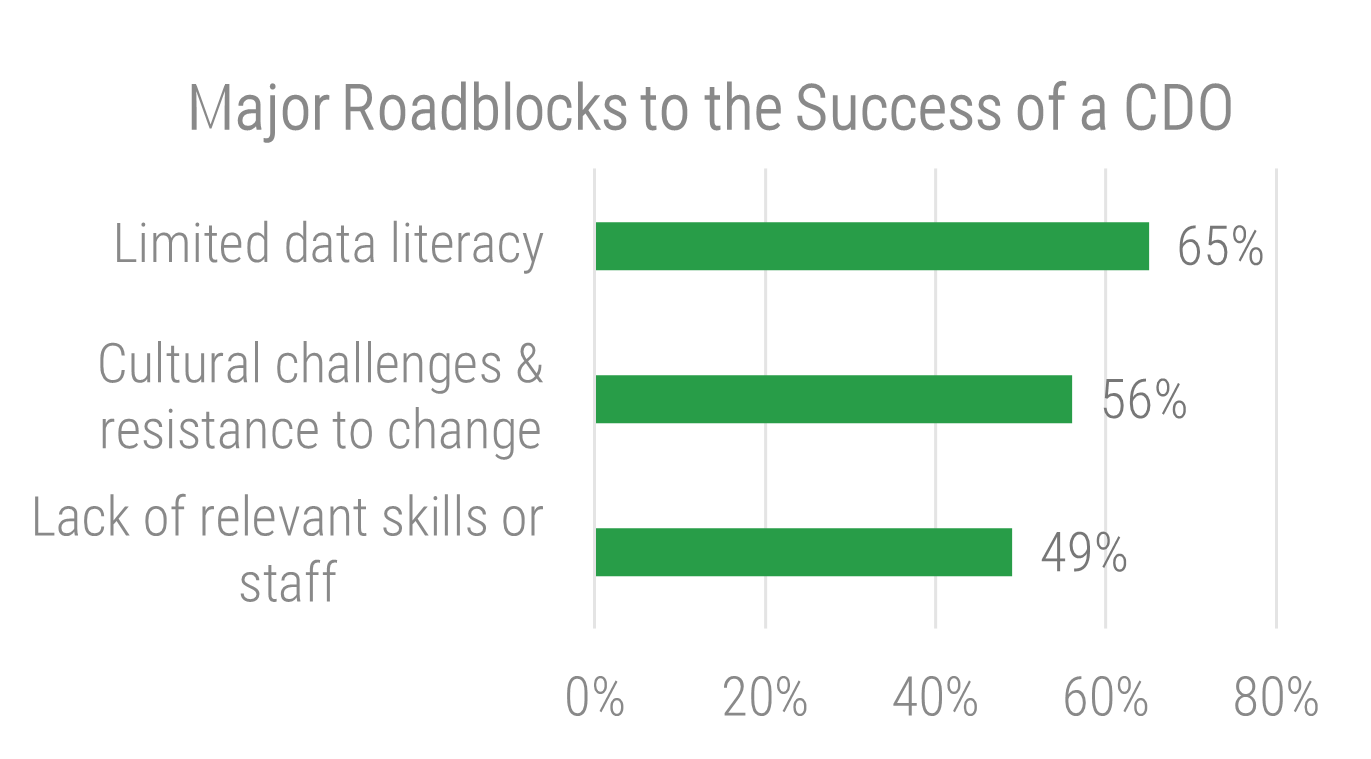
(Source: BearingPoint, 2020)
Five Whys RCA
Problem: Poor data literacy is the top challenge CDOs face when increasing the value of D&A. Why?
- People that lack data literacy find it difficult to embrace and trust the organization's data insights. Why?
- Data workers and the business team don't speak the same language. Why?
- No shared data definition or knowledge is established. Over-extensive data facts do not drive business outcomes. Why?
- Leaders fail to understand that data literacy is more than technical training, it is about encompassing all aspects of business, IT, and data. Why?
- A lack of leadership skills prevents leaders from recognizing these connections and the data team needing to develop soft skills.
Problem: Cultural challenge is one of the biggest obstacles to a CDO's success. Why?
- Decisions are made from gut instinct instead of data-driven insights, thus affecting business performance. Why?
- People within the organization do not believe that data drives operational excellence, so they resist change. Why?
- Companies overestimate the organization's level of data literacy and data maturity. Why?
- A lack of strategies in change management, continuous improvement & data literacy for data initiatives. Why?
- A lack of expertise/leaders possessing these relevant soft skills (e.g. change management, etc.).
As organizations strive to become more data-driven, most conversations around D&A emphasize hard skills. Soft skills like leadership and change management are equally crucial, and deficits there could be the root cause of the data team's inability to demonstrate improved business performance.
Data cannot be fully leveraged without a cohesive data strategy
Business strategy and data strategy are no longer separate entities.
- For any chief data & analytics officer (CDAO) or equivalent data leader, a robust and comprehensive data strategy is the number one tool for generating measurable business value from data. Data leaders should understand what skills are required to achieve these goals, consider the current skills gap, and build development programs to help employees improve those skills.
- Begin your skills development programs by ensuring you have a data strategy plan prepared. A data strategy should never be formulated independently from the business. Organizations with high data maturity will align such efforts to the needs of the business, making data a major part of the business strategy to achieve data centricity.
- Refer to Info-Tech's Build a Robust and Comprehensive Data Strategy blueprint to ensure data can be leveraged as a strategic asset of the organization.
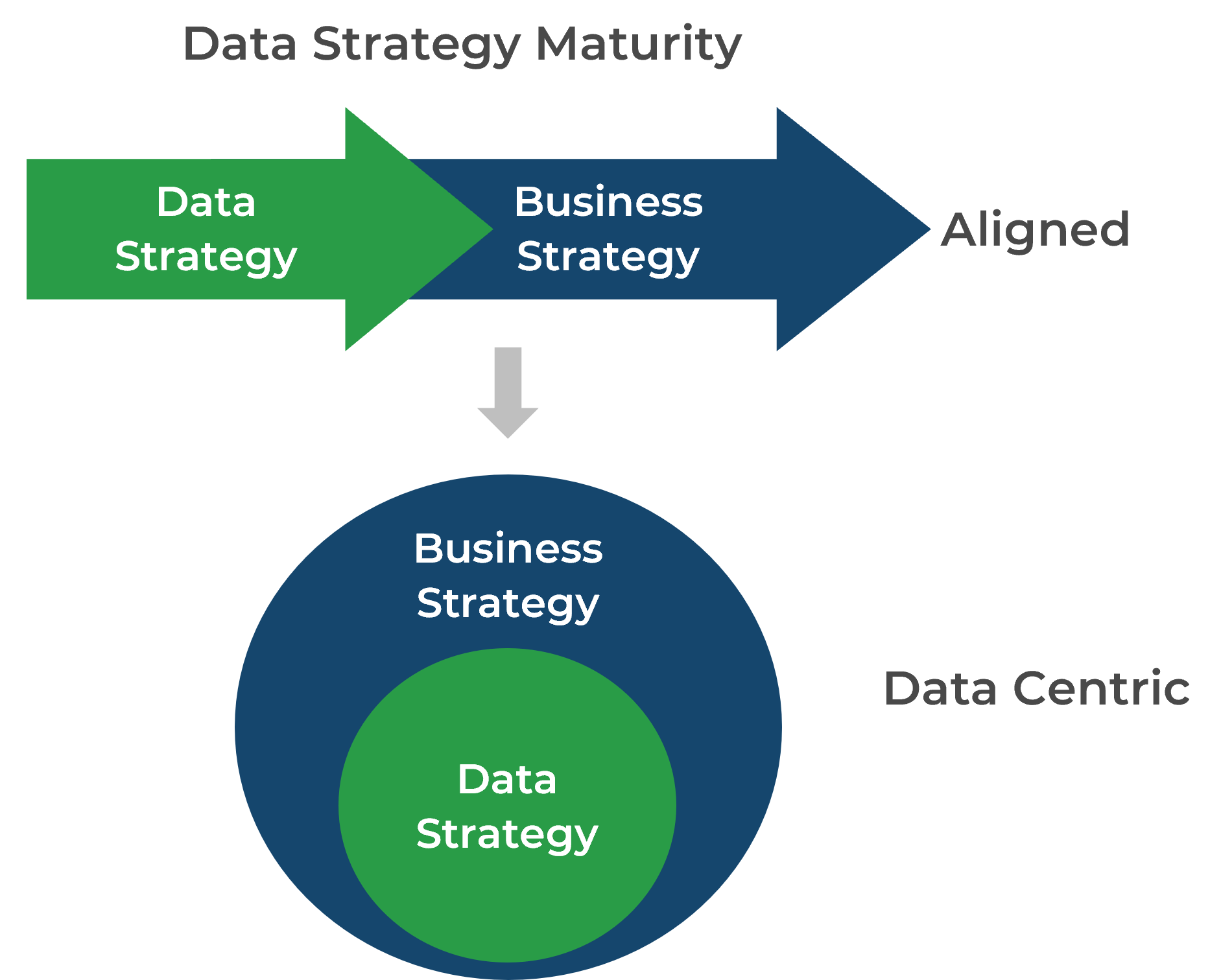
Info-Tech Insight
The process of achieving data centricity requires alignment between the data and business teams, and that requires soft skills.
Follow Info-Tech's methodology to identify the roles and skills needed to execute a data strategy
-
Define Key Roles and Skills
Digital Leadership Skills, Soft Skills, Technical SkillsKey Output
- Defined essential competencies, responsibilities for some common data roles
-
Uncover the Skills Gap
Data Strategy Alignment, High-Level Data Maturity Assessment, Skills Gap AnalysisKey Output
- Data roles and skills aligned with your current data strategy
- Identified current and target state of data skill sets
-
Build an Actionable Plan
Initiative Priority, Skills Growth Feasibility, Hiring FeasibilityKey Output
- Identified action plan to address the risk of data skills deficiency
Info-Tech Insight
Skills gaps are a frequently named obstacle to realizing corporate goals for D&A. Soft skills and technical skills are complementary, and a D&A team needs both to perform effectively. Identify the essential skills and the gap with current skills that fit your organization's data strategy to ensure the right skill is available at the right time and to minimize applicable risks.
Research benefits
Member benefits
- Reduce time spent defining the target state of skill sets.
- Gain ability to reassess the feasibility of execution on your data strategy, including resources and timeline.
- Increase confidence in the data leader's ability to implement a successful skills development program that is aligned with the organization's data strategy, which correlates directly to successful business outcomes.
Business benefits
- Reduce time and cost spent hiring key data roles.
- Increase chance of retaining high-quality data professionals.
- Reduce time loss for delayed progress and rework of initiatives.
- Optimize quality of data initiative implementation.
- Improve data team productivity.
Insight summary
Overarching insight
Skills gaps are a frequently named obstacle to realizing corporate goals for D&A. Soft skills and technical skills are complementary, and a D&A team needs both to perform effectively. Identify the essential skills and the gap with current skills that fit your organization's data strategy to ensure the right skill is available at the right time and to minimize applicable risks.
Phase 1 insight
Technological advancements will inevitably require new technical skills, but the most in-demand skills go beyond mastering the newest technologies. Soft skills are essential to data roles as the global workforce navigates the changes of the last few years.
Phase 2 insight
Understanding and knowing your organization's data maturity level is a prerequisite to assessing your current skill and determining where you must align in the future.
Phase 3 insight
One of the misconceptions that organizations have includes viewing skills development as a one-time effort. This leads to underinvestment in data team skills, risk of falling behind on technological changes, and failure to connect with business partners. Employees must learn to continuously adapt to the changing circumstances of D&A.
While the program must be agile and dynamic to reflect technological improvements in the development of technical skills, the program should always be anchored in soft skills because data management is fundamentally about interaction, collaboration, and people.
Tactical insight
Seeking input and support across your business units can align stakeholders to focus on the right data analytics skills and build a data learning culture.
Info-Tech offers various levels of support to best suit your needs
DIY Toolkit |
Guided Implementation |
Workshop |
Consulting |
| "Our team has already made this critical project a priority, and we have the time and capability, but some guidance along the way would be helpful." | "Our team knows that we need to fix a process, but we need assistance to determine where to focus. Some check-ins along the way would help keep us on track." | "We need to hit the ground running and get this project kicked off immediately. Our team has the ability to take this over once we get a framework and strategy in place." | "Our team does not have the time or the knowledge to take this project on. We need assistance through the entirety of this project." |
Diagnostics and consistent frameworks used throughout all four options |
|||
Guided Implementation
A Guided Implementation (GI) is a series of calls with an Info-Tech analyst to help implement our best practices in your organization.
A typical GI is four to six calls over the course of two to three months.
What does a typical GI on this topic look like?
Phase 1 |
Phase 2 |
Phase 3 |
| Call #1: Understand common data & analytics roles and skills, and your specific objectives and challenges. | Call #2: Assess the current data maturity level and competency of skills set. Identify the skills gap. | Call #3: Identify the relationship between current initiatives and capabilities. Initialize the corresponding roadmap for the data skills development program.
Call #4: (follow-up call) Touching base to follow through and ensure that benefits have received. |
Identify and Build the Data & Analytics Skills Your Organization Needs
Phase 1
Define Key Roles and Skills
| Define Key Roles and Skills | Uncover the Skills Gap | Build an Actionable Plan |
This phase will walk you through the following activities:
- 1.1 Review D&A Skill & Role List in Data & Analytics Assessment and Planning Tool
This phase involves the following participants:
- Data leads
Key resources for your data strategy: People
Having the right role is a key component for executing effective data strategy.
D&A Common Roles
- Data Steward
- Data Custodian
- Data Owner
- Data Architect
- Data Modeler
- Artificial Intelligence (AI) and Machine Learning (ML) Specialist
- Database Administrator
- Data Quality Analyst
- Security Architect
- Information Architect
- System Architect
- MDM Administrator
- Data Scientist
- Data Engineer
- Data Pipeline Developer
- Data Integration Architect
- Business Intelligence Architect
- Business Intelligence Analyst
- ML Validator
AI and ML Specialist is projected to be the fastest-growing occupation in the next five years (World Economic Forum, 2023).
While tech roles take an average of 62 days to fill, hiring a senior data scientist takes 70.5 days (Workable, 2019). Start your recruitment cycle early for this demand.
D&A Leader Roles
- Chief Data Officer (CDO)/Chief Data & Analytics Officer (CDAO)
- Data Governance Lead
- Data Management Lead
- Information Security Lead
- Data Quality Lead
- Data Product Manager
- Master Data Manager
- Content and Record Manager
- Data Literacy Manager
CDOs act as impactful change agents ensuring that the organization's data management disciplines are running effectively and meeting the business' data needs. Only 12.0% of the surveyed organizations reported having a CDO as of 2012. By 2022, this percentage had increased to 73.7% (NewVantage Partners, 2022).
Sixty-five percent of respondents said lack of data literacy is the top challenge CDOs face today (BearingPoint, 2020). It has become imperative for companies to consider building a data literacy program which will require a dedicated data literacy team.
Key resources for your data strategy: Skill sets
Distinguish between the three skills categories.
-
Soft Skills
Soft skills are described as power skills regarding how you work, such as teamwork, communication, and critical thinking. -
Digital Leadership Skills
Not everyone working in the D&A field is expected to perform advanced analytical tasks. To thrive in increasingly data-rich environments, however, every data worker, including leaders, requires a basic technological understanding and skill sets such as AI, data literacy, and data ethics. These are digital leadership skills. -
Technical Skills
Technical skills are the practical skills required to complete a specific task. For example, data scientists and data engineers require programming skills to handle and manage vast amounts of data.
Info-Tech Insight
Technological advancements will inevitably require new technical skills, but the most in-demand skills go beyond mastering the newest technologies. Soft skills are essential to data roles as the global workforce navigates the changes of the last few years.
Soft skills aren't just nice to have
They're a top asset in today's data workplace.
Leadership
- Data leaders with strong leadership abilities can influence the organization's strategic execution and direction, support data initiatives, and foster data cultures. Organizations that build and develop leadership potential are 4.2 times more likely to financially outperform those that do not (Udemy, 2022).
Business Acumen
- The process of deriving conclusions and insights from data is ultimately utilized to improve business decisions and solve business problems. Possessing business acumen helps provide the business context and perspectives for work within data analytics fields.
Critical Thinking
- Critical thinking allows data leaders at every level to objectively assess a problem before making judgment, consider all perspectives and opinions, and be able to make decisions knowing the ultimate impact on results.
Analytical Thinking
- Analytical thinking remains the most important skill for workers in 2023 (World Economic Forum, 2023). Data analytics expertise relies heavily on analytical thinking, which is the process of breaking information into basic principles to analyze and understand the logic and concepts.
Design Thinking & Empathy
- Design thinking skills help D&A professionals understand and prioritize the end-user experience to better inform results and assist the decision-making process. Organizations with high proficiency in design thinking are twice as likely to be high performing (McLean & Company, 2022).
Learning Focused
- The business and data analytics fields continue to evolve rapidly, and the skills, especially technical skills, must keep pace. Learning-focused D&A professionals continuously learn, expanding their knowledge and enhancing their techniques.
Change Management
- Change management is essential, especially for data leaders who act as change agents developing and enabling processes and who assist others with adjusting to changes with cultural and procedural factors. Organizations with high change management proficiency are 2.2 times more likely to be high performing (McLean & Company, 2022).
Resilience
- Being motivated and adaptable is essential when facing challenges and high-pressure situations. Organizations highly proficient in resilience are 1.8 times more likely to be high performing (McLean & Company, 2022).
Managing Risk & Governance Mindset
- Risk management ability is not limited to highly regulated institutions. All data workers must understand risks from the larger organizational perspective and have a holistic governance mindset while achieving their individual goals and making decisions.
Continuous Improvement
- Continuously collecting feedback and reflecting on it is the foundation of continuous improvement. To uncover and track the lessons learned and treat them as opportunities, data workers must be able to discover patterns and connections.
Teamwork & Collaboration
- Value delivery in a data-centric environment is a team effort, requiring collaboration across the business, IT, and data teams. D&A experts with strong collaborative abilities can successfully work with other teams to achieve shared objectives.
Communication & Active Listening
- This includes communicating with relevant stakeholders about timelines and expectations of data projects and associated technology and challenges, paying attention to data consumers, understanding their requirements and needs, and other areas of interest to the organization.
Technical skills for everyday excellence
Digital Leadership Skills
- Technological Literacy
- Data and AI Literacy
- Cloud Computing Literacy
- Data Ethics
- Data Translation
Data & Analytics Technical Competencies
- Data Mining
- Programming Languages (Python, SQL, R, etc.)
- Data Analysis and Statistics
- Computational and Algorithmic Thinking
- AI/ML Skills (Deep Learning, Computer Vision, Natural Language Processing, etc.)
- Data Visualization and Storytelling
- Data Profiling
- Data Modeling & Design
- Data Pipeline (ETL/ELT) Design & Management
- Database Design & Management
- Data Warehouse/Data Lake Design & Management
1.1 Review D&A Skill & Role List in the Data & Analytics Assessment and Planning Tool
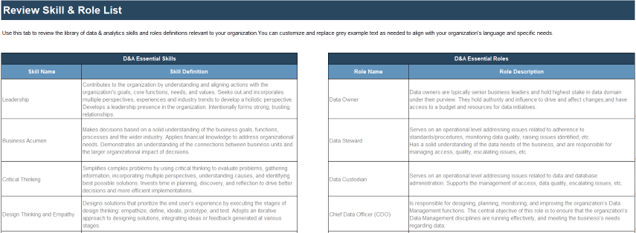
Tab 2. Skill & Role List
Objective: Review the library of skills and roles and customize them as needed to align with your organization's language and specific needs.
Download the Data & Analytics Assessment and Planning Tool
Identify and Build the Data & Analytics Skills Your Organization Needs
Phase 2
Uncover the Skills Gap
| Define Key Roles and Skills | Uncover the Skills Gap | Build an Actionable Plan |
This phase will walk you through the following activities:
- 2.1 High-level assessment of your present data management maturity
- 2.2 Interview business and data leaders to clarify current skills availability
- 2.3 Use the Data & Analytics Assessment and Planning Tool to Identify your skills gaps
This phase involves the following participants:
- Data leads
- Business leads and subject matter experts (SMEs)
- Key business stakeholders
Identify skills gaps across the organization
Gaps are not just about assigning people to a role, but whether people have the right skill sets to carry out tasks.
- Now that you have identified the essential skills and roles in the data workplace, move to Phase 2. This phase will help you understand the required level of competency, assess where the organization stands today, and identify gaps to close.
- Using the Data & Analytics Assessment and Planning Tool, start with areas that are given the highest priority through a high-level maturity assessment. From there, three levels of gaps will be found: whether people are assigned to a particular position, the right combination of D&A skill sets, and the right competency level for each skill.
-
Lack of talent assigned to a position
-
Lack of the right combination of D&A skill sets
-
Lack of appropriate competency level
Info-Tech Insight
Understanding your organization's data maturity level is a prerequisite to assessing the skill sets you have today and determining where you need to align in the future.
2.1 High-level assessment of your present data management maturity
Identifying and fixing skills gaps takes time, money, and effort. Focus on bridging the gap in high-priority areas.
Input: Current state capabilities, Use cases (if applicable), Data culture diagnostic survey results (if applicable)
Output: High-level maturity assessment, Prioritized list of data management focused area
Materials: Data Management Assessment and Planning Tool (optional), Data & Analytics Assessment and Planning Tool
Participants: Data leads, Business leads and subject matter experts (SMEs), Key business stakeholders
Objectives:
Prioritize these skills and roles based on your current maturity levels and what you intend to accomplish with your data strategy.
Steps:
- (Optional Step) Refer to the Build a Robust and Comprehensive Data Strategy blueprint. You can assess your data maturity level using the following frameworks and methods:
- Review current data strategy and craft use cases that represent high-value areas that must be addressed for their teams or functions.
- Use the data culture assessment survey to determine your organization's data maturity level.
- (Optional Step) Refer to the Create a Data Management Roadmap blueprint and Data Management Assessment and Planning Tool to dive deep into understanding and assessing capabilities and maturity levels of your organization's data management enablers and understanding your priority areas and specific gaps.
- If you have completed Data Management Assessment and Planning Tool, fill out your maturity level scores for each of the data management practices within it - Tab 3 (Current-State Assessment). Skip Tab 4 (High-Level Maturity Assessment).
- If you have not yet completed Data Management Assessment and Planning Tool, skip Tab 3 and continue with Tab 4. Assign values 1 to 3 for each capability and enabler.
- You can examine your current-state data maturity from a high level in terms of low/mid/high maturity using either Tabs 3 or 4.
- Suggested focus areas along the data journey:
- Low Maturity = Data Strategy, Data Governance, Data Architecture
- Mid Maturity = Data Literacy, Information Management, BI and Reporting, Data Operations Management, Data Quality Management, Data Security/Risk Management
- High Maturity = MDM, Data Integration, Data Product and Services, Advanced Analytics (ML & AI Management).
Download the Data & Analytics Assessment and Planning Tool
2.2 Interview business and data leaders to clarify current skills availability
1-2 hours per interview
Input: Sample questions targeting the activities, challenges, and opportunities of each unit
Output: Identified skills availability
Materials: Whiteboard/Flip charts, Data & Analytics Assessment and Planning Tool
Participants: Data leads, Business leads and subject matter experts (SMEs), Key business stakeholders
Instruction:
- Conduct a deep-dive interview with each key data initiative stakeholder (data owners, SMEs, and relevant IT/Business department leads) who can provide insights on the skill sets of their team members, soliciting feedback from business and data leaders about skills and observations of employees as they perform their daily tasks.
- Populate a current level of competency for each skill in the Data & Analytics Assessment and Planning Tool in Tabs 5 and 6. Having determined your data maturity level, start with the prioritized data management components (e.g. if your organization sits at low data maturity level, start with identifying relevant positions and skills under data governance, data architecture, and data architecture elements).
- More detailed instructions on how to utilize the workbook are at the next activity.
Key interview questions that will help you :
- Do you have personnel assigned to the role? What are their primary activities? Do the personnel possess the soft and technical skills noted in the workbook? Are you satisfied with their performance? How would you evaluate their degree of competency on a scale of "vital, important, nice to have, or none"? The following aspects should be considered when making the evaluation:
- Key Performance Indicators (KPIs): Business unit data will show where the organization is challenged and will help identify potential areas for development.
- Project Management Office: Look at successful and failed projects for trends in team traits and competencies.
- Performance Reviews: Look for common themes where employees excel or need to improve.
- Focus Groups: Speak with a cross section of employees to understand their challenges.
- What technology is currently used? Are there requirements for new technology to be bought and/or optimized in the future? Will the workforce need to increase their skill level to carry out these activities with the new technology in place?
Download the Data & Analytics Assessment and Planning Tool
2.3 Use the Data & Analytics Assessment and Planning Tool to identify skills gaps
1-3 hours — Not everyone needs the same skill levels.
Input: Current skills competency, Stakeholder interview results and findings
Output: Gap identification and analysis
Materials: Data & Analytics Assessment and Planning Tool
Participants: Data leads
Instruction:
- Select your organization's data maturity level in terms of Low/Mid/High in cell A6 for both Tab 5 (Soft Skills Assessment) and Tab 6 (Technical Skills Assessment) to reduce irrelevant rows.
- Bring together key business stakeholders (data owners, SMEs, and relevant IT custodians) to determine whether the data role exists in the organization. If yes, assign a current-state value from “vital, important, nice to have, or none” for each skill in the assessment tool. Info-Tech has specified the desired/required target state of each skill set.
- Once you've assigned the current-state values, the tool will automatically determine whether there is a gap in skill set.
Download the Data & Analytics Assessment and Planning Tool
Identify and Build the Data & Analytics Skills Your Organization Needs
Phase 3
Build an Actionable Plan
| Define Key Roles and Skills | Uncover the Skills Gap | Build an Actionable Plan |
This phase will walk you through the following activities:
- 3.1 Use the Data & Analytics Assessment and Planning Tool to build your actionable roadmap
This phase involves the following participants:
- Data leads
- Business leads and subject matter experts (SMEs)
- Key business stakeholders
Determine next steps and decision points
There are three types of internal skills development strategies
- There are three types of internal skills development strategies organizations can use to ensure the right people with the right abilities are placed in the right roles: reskill, upskill, and new hire.
-
Reskill
Reskilling involves learning new skills for a different or newly defined position. -
Upskill
Upskilling involves building a higher level of competency in skills to improve the worker's performance in their current role. -
New hire
New hire involves hiring workers who have the essential skills to fill the open position.
Info-Tech Insight
One of the misconceptions that organizations have includes viewing skills development as a one-time effort. This leads to underinvestment in data team skills, risk of falling behind on technological changes, and failure to connect with business partners. Employees must learn to continuously adapt to the changing circumstances of D&A. While the program must be agile and dynamic to reflect technological improvements in the development of technical skills, the program should always be anchored in soft skills because data management is fundamentally about interaction, collaboration, and people.
How to determine when to upskill, reskill, or hire to meet your skills needs
Reskill
Reskilling often indicates a change in someone's career path, so this decision requires a goal aligned with both individuals and the organization to establish a mutually beneficial situation.
When making reskilling decisions, organizations should also consider the relevance of the skill for different positions. For example, data administrators and data architects have similar skill sets, so reskilling is appropriate for these employees.
Upskill
Upskilling tends to focus more on the soft skills necessary for more advanced positions. A data strategy lead, for example, might require design thinking training, which enables leaders to think from different perspectives.
Skill growth feasibility must also be considered. Some technical skills, particularly those involving cutting-edge technologies, require continual learning to maintain operational excellence. For example, a data scientist may require AI/ML skills training to incorporate use of modern automation technology.
New Hire
For open positions and skills that are too resource-intensive to reskill or upskill, it makes sense to recruit new employees. Consider, however, time and cost feasibility of hiring. Some positions (e.g. senior data scientist) take longer to fill. To minimize risks, coordinate with your HR department and begin recruiting early.
Data & Analytics skills training
There are various learning methods that help employees develop priority competencies to achieve reskilling or upskilling.
Specific training
The data team can collaborate with the human resources department to plan and develop internal training sessions aimed at specific skill sets.
This can also be accomplished through external training providers such as DCAM, which provides training courses on data management and analytics topics.
Formal education program
Colleges and universities can equip students with data analytics skills through formal education programs such as MBAs and undergraduate or graduate degrees in Data Science, Machine Learning, and other fields.
Certification
Investing time and effort to obtain certifications in the data & analytics field allows data workers to develop skills and gain recognition for continuous learning and self-improvement.
AWS Data Analytics and Tableau Data Scientist Certification are two popular data analytics certifications.
Online learning from general providers
Some companies offer online courses in various subjects. Coursera and DataCamp are two examples of popular providers.
Partner with a vendor
The organization can partner with a vendor who brings skills and talents that are not yet available within the organization. Employees can benefit from the collaboration process by familiarizing themselves with the project and enhancing their own skills.
Support from within your business
The data team can engage with other departments that have previously done skills development programs, such as Finance and Change & Communications, who may have relevant resources to help you improve your business acumen and change management skills.
Info-Tech Insight
Seeking input and support across your business units can align stakeholders to focus on the right data analytics skills and build a data learning culture.
Data & Analytics skills reinforcement
Don't assume learners will immediately comprehend new knowledge. Use different methods and approaches to reinforce their development.
Innovation Space
- Skills development is not a one-time event, but a continuous process during which innovation should be encouraged. A key aspect of being innovative is having a “fail fast” mentality, which means collecting feedback, recognizing when something isn't working, encouraging experimentation, and taking a different approach with the goal of achieving operational excellence.
- Human-centered design (HCD) also yields innovative outcomes with a people-first focus. When creating skills development programs for various target groups, organizations should integrate a human-centered approach.
Commercial Lens
- Exposing people to a commercial way of thinking can add long-term value by educating people to act in the business' best interest and raising awareness of what other business functions contribute. This includes concepts such as project management, return on investment (ROI), budget alignment, etc.
Checklists/Rubrics
- Employees should record what they learn so they can take the time to reflect. A checklist is an effective technique for establishing objectives, allowing measurement of skills development and progress.
Buddy Program
- A buddy program helps employees gain and reinforce knowledge and skills they have learned through mutual support and information exchange.
Align HR programs to support skills integration and talent recruitment
With a clear idea of skills needs and an executable strategy for training and reinforcing of concepts, HR programs and processes can help the data team foster a learning environment and establish a recruitment plan. The links below will direct you to blueprints produced by McLean & Company, a division of Info-Tech Research Group.
Workforce Planning
When integrating the skills of the future into workforce planning, determine the best approach for addressing the identified talent gaps – whether to build, buy, or borrow.
Integrate the future skills identified into the organization's workforce plan.
Talent Acquisition
In cases where employee development is not feasible, the organization's talent acquisition strategy must focus more on buying or borrowing talent. This will impact the TA process. For example, sourcing and screening must be updated to reflect new approaches and skills.
If you have a talent acquisition strategy, assess how to integrate the new roles/skills into recruiting.
Competencies/Succession Planning
Review current organizational core competencies to determine if they need to be modified. New skills will help inform critical roles and competencies required in succession talent pools.
If no competency framework exists, use McLean & Company's Develop a Comprehensive Competency Framework blueprint.
Compensation
Evaluate modified and new roles against the organization's compensation structure. Adjust them as necessary. Look at market data to understand compensation for new roles and skills.
Reassess your base pay structure according to market data for new roles and skills.
Learning and Development
L&D plays a huge role in closing the skills gap. Build L&D opportunities to support development of new skills in employees.
Design an Impactful Employee Development Program to build the skills employees need in the future.
3.1 Use the Data & Analytics Assessment and Planning Tool to build an actionable plan
1-3 hours
Input: Roles and skills required, Key decision points
Output: Actionable plan
Materials: Data & Analytics Assessment and Planning Tool
Participants: Data leads, Business leads and subject matter experts (SMEs), Key business stakeholders
Instruction:
- On Tab 7 (Next Steps & Decision Points), you will find a list of tasks that correspond to roles that where there is a skills gap.
- Customize this list of tasks initiatives according to your needs.
- The Gantt chart, which will be generated automatically after assigning start and finish dates for each activity, can be used to structure your plan and guarantee that all the main components of skills development are addressed.

Download the Data & Analytics Assessment and Planning Tool
Related Info-Tech Research
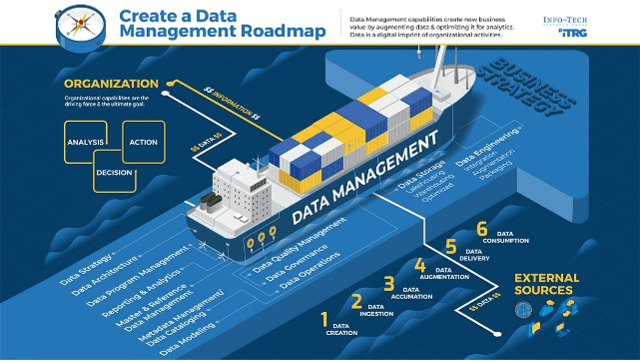
Create a Data Management Roadmap
- This blueprint will help you design a data management practice that will allow your organization to use data as a strategic enabler.

Build a Robust and Comprehensive Data Strategy
- Put a strategy in place to ensure data is available, accessible, well-integrated, secured, of acceptable quality, and suitably visualized to fuel organization-wide decision making. Start treating data as strategic and corporate asset.
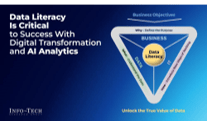
Foster Data-Driven Culture With Data Literacy
- By thoughtfully designing a data literacy training program appropriate to the audience's experience, maturity level, and learning style, organizations build a data-driven and engaged culture that helps them unlock their data's full potential and outperform other organizations.
Research Authors and Contributors
Authors:
| Name | Position | Company |
| Ruyi Sun | Research Specialist | Info-Tech Research Group |
Contributors:
| Name | Position | Company |
| Steve Wills | Practice Lead | Info-Tech Research Group |
| Andrea Malick | Advisory Director | Info-Tech Research Group |
| Annabel Lui | Principal Advisory Director | Info-Tech Research Group |
| Sherwick Min | Technical Counselor | Info-Tech Research Group |
Bibliography
2022 Workplace Learning Trends Report.” Udemy, 2022. Accessed 20 June 2023.
Agrawal, Sapana, et al. “Beyond hiring: How companies are reskilling to address talent gaps.” McKinsey & Company, 12 Feb. 2020. Accessed 20 June 2023.
Bika, Nikoletta. “Key hiring metrics: Useful benchmarks for tech roles.” Workable, 2019. Accessed 20 June 2023.
Chroust, Tomas. “Chief Data Officer – Leaders of data-driven enterprises.” BearingPoint, 2020. Accessed 20 June 2023.
“Data and AI Leadership Executive Survey 2022.” NewVantage Partners, Jan 2022. Accessed 20 June 2023.
Dondi, Marco, et al. “Defining the skills citizens will need in the future world of work.” McKinsey & Company, June 2021. Accessed 20 June 2023.
Futschek, Gerald. “Algorithmic Thinking: The Key for Understanding Computer Science.” Lecture Notes in Computer Science, vol. 4226, 2006.
Howard, William, et al. “2022 HR Trends Report.” McLean & Company, 2022. Accessed 20 June 2023.
“Future of Jobs Report 2023.” World Economic Forum, May 2023. Accessed 20 June 2023.
Knight, Michelle. “What is Data Ethics?” Dataversity, 19 May 2021. Accessed 20 June 2023.
Little, Jim, et al. “The CIO Imperative: Is your technology moving fast enough to realize your ambitions?” EY, 22 Apr. 2022. Accessed 20 June 2023.
“MDM Roles and Responsibilities.” Profisee, April 2019. Accessed 20 June 2023.
“Reskilling and Upskilling: A Strategic Response to Changing Skill Demands.” TalentGuard, Oct. 2019. Accessed 20 June 2023.
Southekal, Prashanth. “The Five C's: Soft Skills That Every Data Analytics Professional Should Have.” Forbes, 17 Oct. 2022. Accessed 20 June 2023.